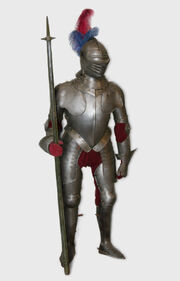| Livonian Order | |
|---|---|
  1. Seal of the Livonian Order's master 2.Coat of Arms of Teutonic Knights in the Livonian Order | |
| Active | 1237–1561 |
| Country | State of the Teutonic Order (1237-1435) Livonian Confederation (1435-1561) |
| Branch | Teutonic Order |
| Garrison/HQ | Wenden(Cēsis), Fellin (Viljandi) |
| Battle honours | Northern Crusades, Battle of the Ice, Livonian War |
Template:History of Latvia

Body armor used by the Livonian Order
The Livonian Order was an autonomous Livonian branch of the Teutonic Order [1] and a member of the Livonian Confederation from 1435–1561. After being defeated by Samogitians in the 1236 Battle of Schaulen (Saule), the remnants of the Livonian Brothers of the Sword were incorporated into the Teutonic Knights and became known as the Livonian Order in 1237.[2]
Between 1237 and 1290, the Livonian Order conquered all of Courland, Livonia, and Semigallia, but the Order's attempts to invade the neighboring Novgorod Republic were unsuccessful and its army was eventually defeated in the Battle of Rakvere (1268). In 1346, the Order bought the Duchy of Estonia from King Valdemar IV of Denmark. Life within the Order's territory is described in the Chronicle of Balthasar Russow (Chronica der Provinz Lyfflandt).
The Teutonic Order fell into decline following its defeat in the Battle of Grunwald in 1410 and the secularization of its Prussian territories by Albert of Brandenburg in 1525, but the Livonian Order managed to maintain an independent existence.
The Livonian Order's defeat in the Battle of Swienta (Pabaiskas) on September 1, 1435, which claimed the lives of the master and several high ranking knights, brought the order closer to its neighbors in Livonia. The Livonian Confederation agreement (eiine fruntliche eyntracht) was signed in Walk on December 4. 1435 by the archbishop of Riga, the bishops of Courland, Dorpat, Ösel-Wiek and Reval; the representatives of the Livonan Order and vassals, and the deputies of Riga, Reval and Dorpat city municipal councils.[3]
During the Livonian War, however, the Order suffered a decisive defeat by troops of Muscovite Russia in the Battle of Ergeme in 1560. The Livonian Order then sought protection from Sigismund II Augustus, the King of Poland and the Grand Duke of Lithuania, who had intervened in a war between Bishop William of Riga and the Brothers in 1557.
After coming to an agreement with Sigismund II Augustus and his representatives (especially Mikołaj "the Black" Radziwiłł), the last Livonian Master, Gotthard Kettler, secularized the Order and converted to Lutheranism. In the southern part of the Brothers' lands he created the Duchy of Courland and Semigallia for his family. Most of the remaining lands were seized by the Grand Duchy of Lithuania. The north of Estonia was taken back by Denmark and Sweden.
From the 14th to the 16th centuries, Middle Low German as spoken in the towns of the Hanseatic League was the established language, but was subsequently succeeded by High German as official language in the course of the 16th and 17th centuries.[4]
Masters of the Livonian Order[]
The Livonian Master like the grandmaster of the Teutonic Order was elected by his fellow knights for a lifetime term. The grandmaster exercised supervisory powers and his advice was considered equal to a command. The grandmaster of Teutonic knights did not limit local autonomy, he rarely visited Livonia or sent ambassadors for oversight.[5]
- Hermann Balk 1237–38
- Dietrich von Grüningen 1238–42
- Dietrich von Grüningen 1244–46
- Andreas von Stierland 1248–53
- Anno von Sangershausen 1253–56
- Burchard von Hornhausen 1256–60
- Werner von Breithausen 1261–63
- Konrad von Mandern 1263–66
- Otto von Lutterberg (c1220-1270) 1266–70
- Walther von Nortecken 1270–73
- Ernst von Rassburg 1273–79
- Konrad von Feuchtwangen 1279–81
- Wilken von Endorp 1281–87
- Konrad von Herzogenstein 1288–90
- Halt von Hohembach –1293
- Heinrich von Dinkelaghe 1295–96
- Bruno 1296–98
- Gottfried von Rogga 1298–1307
- Conrad von Jocke 1309–22
- Johannes Ungenade 1322–24
- Reimar Hane 1324–28
- Everhard von Monheim 1328–40
- Burchard von Dreileben 1340–45
- Goswin von Hercke 1345–59
- Arnold von Vietinghof 1359–64
- Wilhelm von Vrymersheim 1364–85
- Robin von Eltz 1385–89
- Wennemar Hasenkamp von Brüggeneye 1389–1401
- Konrad von Vietinghof 1401–13
- Diderick Tork 1413–15
- Siegfried Lander von Spanheim 1415–24
- Zisse von Rutenberg 1424–33
- Franco Kerskorff 1433–35
- Heinrich von Bockenvorde 1435–37
- Heinrich Vinke von Overbergen 1438–50
- Johann Osthoff von Mengede 1450–69
- Johann Wolthuss von Herse 1470–71
- Bernd von der Borch 1471–83
- Johann Fridach von Loringhofe 1483–94
- Wolter von Plettenberg 1494–1535
- Hermann Hasenkamp von Brüggeneye 1535–49
- Johann von der Recke 1549–51
- Heinrich von Galen 1551–57
- Johann Wilhelm von Fürstenberg 1557–59
- Godert (Gotthard) Kettler 1559–61
Commanderies of the Livonian Order[]
- Komturei Reval
- Komturei Pernau
- Komturei Jerwen
- Komturei Fellin
- Komturei Talkhof
- Komturei Marienburg
- Landmarschall Segewold
- Ordensmeister (Komturei) Dünamünde
- Komturei Ascheraden
- Komturei Dünaburg
- Komturei Bauske
- Komturei Mitau
- Komturei Doblen
- Komturei Goldingen
- Komturei Windau
References[]
- ^ Urban, William (2005). The Teutonic Knights: A Military History. pp. 259–273. ISBN 1853676675. http://books.google.com/books?id=zzwXIQAACAAJ&dq.
- ^ Frucht, Richard C. (2005). Eastern Europe: An Introduction to the People, Lands, and Culture. ABC-CLIO. pp. 69. ISBN 1576078000. http://books.google.com/books?id=lVBB1a0rC70C&pg=PA69&dq=%22Livonian+order%22&ei=CORZSO-qNZyMjAH29rG1Cw&sig=19vohCih2OzYTuGz2x64UwHxopQ#PPA69,M1.
- ^ Raudkivi, Priit (2007). Vana-Liivimaa maapäev. Argo. pp. 118–119. ISBN 9949415845. http://books.google.com/books?id=4QxtGQAACAAJ&dq.
- ^ Koch, Kristine (2002) (in German). Deutsch als Fremdsprache im Russland des 18. Jahrhunderts. Die Geschichte des Deutschen als Fremdsprache. 1. Berlin/New York: Walter de Gruyter. p. 59. ISBN 3110175037.
- ^ Urban, William L (2004). Livonian Crusade. Lithuanian Research and Studies Center. pp. 12, 14. ISBN 0929700457. http://books.google.com/books?id=h9BTAAAACAAJ&dq.
| This page uses content from the English language Wikipedia. The original content was at Livonian Order. The list of authors can be seen in the page history. As with this Familypedia wiki, the content of Wikipedia is available under the Creative Commons License. |